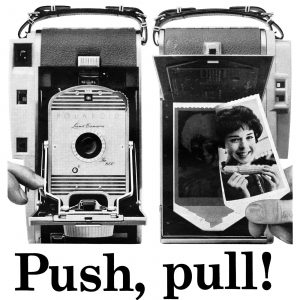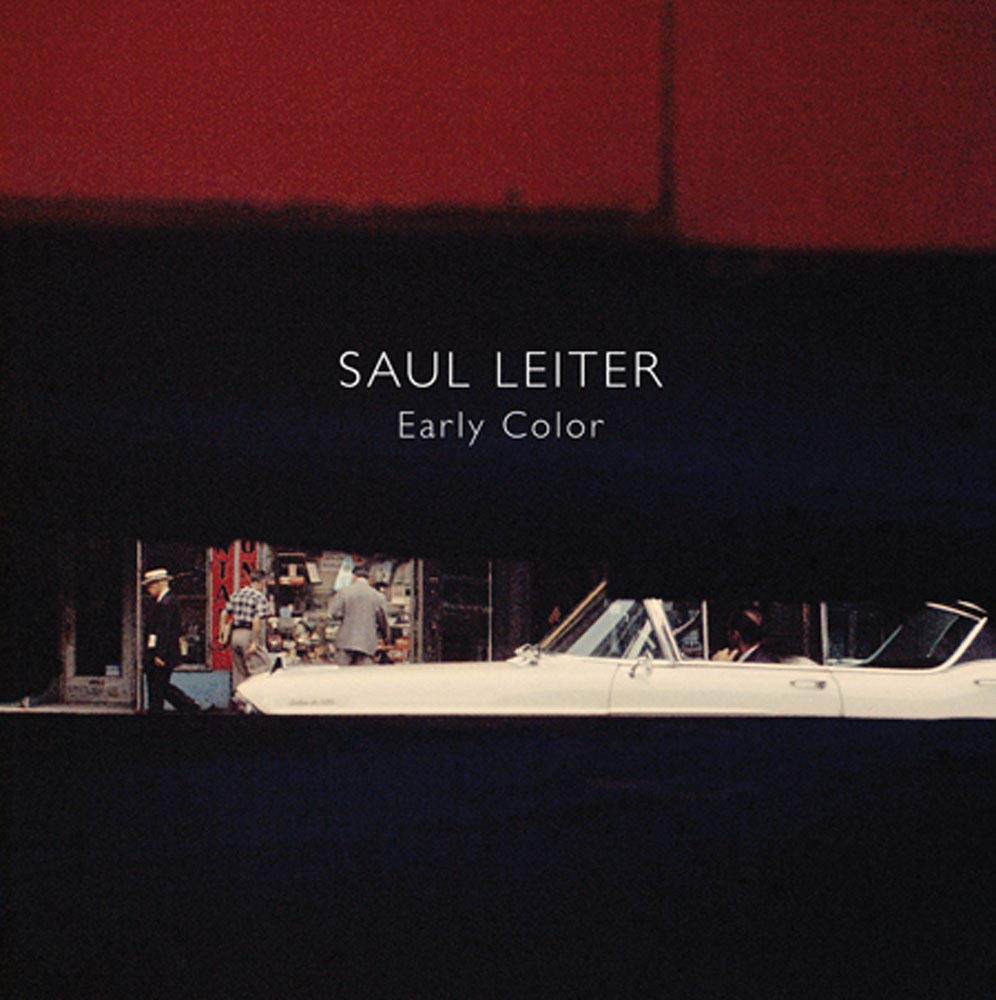In: Art history

The Polaroid Book : Selections from the Polaroid Collections of Photography
January 5, 2023The Polaroid Book : Selections from the Polaroid Collections of Photography
Edited by Steve Crist, Essay by Barbara Hitchcock
Taschen 2005

As a photographer, and especially as one who has shot a lot of instant film, I could wax poetic about the wonders of the Polaroid film process; that it was invented in 1947 by Edwin Land and his Polaroid Corporation; that he formed a partnership with Ansel Adams to explore the artistic capabilities of the medium in 1948; that Land and the Corporation made hundreds of cameras and film available to artists around the world on the condition that they gave some of their images to Polaroid’s collection of photos. I could tell you that it was THE photographic medium of the 50’s, 60’s, 70’s and 80’s and that creating a photo was indeed as easy as “Push, pull!”. However, there are so many writers and photographers out there who have extolled the virtues of the process over the last 75 years that I can’t possibly say anything new.
The Polaroid Book : Selections from the Polaroid Collections of Photography tells the story in 254 photographs by 203 artists. The photos include black and white documentary and landscape images taken with the cumbersome early models of the Polaroid line of cameras to incredibly immersive large format color images made by celebrated artists and fashion photographers. The creativity in these polaroids is boundless. From Adams to Warhol with a little Close and Hockney in between, Polaroids were a tool used by well (and lesser) known artists to create stunning pieces of work. Chuck Close’s Self-portrait (seen below) stands out; a mosaic made up of 9 separate images to create a large, somewhat disjointed selfie in Close’s trademark (and usually painted) style.
Perusing this book will lead you to want to try capturing this photo-magic yourself, which you can do by using Fujifilm’s Instax line of film and cameras. Anecdotal evidence points to these colourful, well designed cameras acting as lures to teens everywhere to further explore the possibility available to them in analog photography as a creative outlet. It is one of the reasons that film sales are quickly growing again after years of domination of the market by digital photography.
The Polaroid Book is available from numerous online and bricks-and-mortar retailers.
~ Mark Walton
Read More
The Sketchbooks of Tom Forrestall
October 13, 2022curated.’s Virgil Hammock offers some thoughts on the voluminous and impressive notebooks of Canadian artist Tom Forrestall in tandem with an exhibition titled The Sketchbooks of Tom Forrestall at The Saint Johns Art Centre.
Read More
Gun Play | Jill Freedman
August 8, 2022Jill Freedman is a name you should know in the world of photography… but more than likely don’t. With a career that spanned 40 years, 7 (and counting) books and pieces acquired by major galleries, Freedman’s work connects deeply with her subjects in a manner unlike most documentary photographers.
From the very beginning, Jill was IN. She didn’t go to take photos of Resurrection City in Washington in 1968; she LIVED in the camp with the protesters for the duration of that campaign. She travelled with the circus for several months in the early 70’s to get her incredible photos of life under and around the big top. She embedded herself in the firehouses and police precincts of NYC and came out with work so beautiful and intimate that her two books on the subjects (Firehouse and Street Cops) were snapped up by first responders when they were re-released in the early 2000’s.
When Pulitzer Prize winner Studs Terkel wrote his oral history Working in 1974, Jill Freedman was who he interviewed when talking about photographers. From the first time I saw her work, I knew that there was an extreme tension in how she approached it. “Sometimes it’s hard to get started, ’cause I’m always aware of invading privacy. If there’s someone who doesn’t want me to take their picture, I don’t. When should you shoot and when shouldn’t you? I’ve gotten pictures of cops beating people. Now they didn’t want their pictures taken. (Laughs.) That’s a different thing.”[i] Freedman walked a very thin line between rooting for the underdog yet respecting authority.
You can find out more about Jill Freedman at http://www.jillfreedman.com/. Resurrection City, 1968 was recently re-published and can be found for purchase at your favorite bookstore or online. Firehouse and Street Cops are no longer in print, but used copies can be found online.
[i] Working: People Talk About What They Do All Day and How They Feel About What They Do by Studs Terkel Text © 1972, 1974 by Studs Terkel – The New Press, New York, 2004, Pg. 153-154
~ Mark Walton
Read More
Take The Long Way Home | Jon Claytor
July 25, 2022High culture has pretty much disappeared along with the dress code.
Read More
Walker Evans – James R. Mellow
May 19, 2022Walker Evans
James R. Mellow
Basic Books; Revised ed. edition (Oct. 11 2001)
Walker Evans is one of the most famous American documentary photographers of the past 100 years and his images will stand for another hundred at least. While every serious photographer is familiar with his work (the best known of which was shot during the 1930’s for the U.S. Farm Security Administration as per the examples below), there have been relatively few books that discuss Evans as a man. James R. Mellow captures his complexities in this eminently readable biography, published in 2001.
What makes particularly interesting reading is Evan’s evolution as an artist, from failed student in the Mid-West US, to failed writer in Paris, to acclaimed photographer on his return to New York in the late 20’s and early 30’s. The book quotes extensively from his letters and other writings. One can almost hear him speaking… I imagine his voice to be a low pitched, slow drawl; a mix of Henry Fonda, Peter Coyote and Alan Rickman (minus the accent).
Evans comes across as dour and fatalistic, yet strangely still likeable. Much of his writing describes his unhappiness with things as they are, whether it be his annoyance with his mother, his dissatisfaction with the quality of the prints made from his negatives or his despondence about his romantic relationships. Many of his friendships with other famous artists are discussed, including Ben Shahn, Steven Crane and Hanns Skolle.
The book offers details about the trips Evans made to do his photography and specifically the trips he made with author James Agee as they worked on the seminal Let Us Now Praise Famous Men. Evans plays the role of aesthete opposite Agee’s sensualist, the collision of which resulted in a book acclaimed for its intimacy and realism… a strong documentary account of the lives of sharecroppers and their families in the American South during the Great Depression.
It is sad but somehow inevitable that Evans ends his days as somewhat of an alcoholic / academic recluse. Mellow’s reliance on Evans’ own words leave you feeling as if you really knew him, that you cared about him, but weren’t overly close to the actual man behind the photographs, because of his determination to keep people at bay.
Walker Evans by James R. Mellow is available from numerous online retailers.
~ Mark Walton
Read More
Kary Janousek – Connecting to History
March 11, 2022Kary Janousek Connecting to History Wind - Kary Janousek Kary Janousek is a prairie transplant. She found herself living in Fargo,... Read More

Temptation of Saint Anthony | Hieronymus Bosch
January 18, 2022High culture has pretty much disappeared along with the dress code.
Read More
Why Black and White Still Matters – An Essay
December 6, 2021High culture has pretty much disappeared along with the dress code.
Read More
Saul Leiter Early Color
May 19, 2021Saul Leiter
Steidl
Currently Out of Print, copies available on Amazon or at specialty bookstores.
Saul Leiter – Early Color is a must have for the library of any street photographer who shoots in color. Leiter’s work is not as confrontational as that of Robert Frank and seeks to find moments of the sublime in every day life and scenes. Shooting with expired and “artisanal” films in the 1950’s gave Leiter a palette unmatched by others, making Early Color breathtaking in it’s ability to capture one with a block of red and yellow on a taxi, or to draw you in to the lives of those sitting behind a window in a New York café.
Originally a rabbinical student (Leiter’s father was an important Talmud scholar), Leiter rebelled against his parent’s hopes for him and started shooting black and white fashion photography in New York. He embraced color before many of his contemporaries.
~ Mark Walton
Read More
A Closer Look : Reading a Photograph
October 28, 2020An independent commentary on photography by Peppa Martin.
Read More
Recent Comments